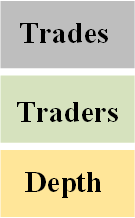Given that secondary markets perform an important economic function, what are the characteristics of good markets? Among the most important are accurate pricing of stocks and liquidity.
Accurate pricing of stocks
Both the buyer and seller want the price to be fair
Liquidity
The ease at which an asset can be converted to cash
One of the most important roles of secondary markets is establishing security prices. Setting accurate prices is not trivial. Consider the case in which something is bought secondhand. Both buyer and seller want the exchange price to be fair.
The problem is how to set a fair price when neither the buyer nor the seller knows the price other people have set for the item. Let us consider two secondhand items: a car and a desk.
Example
Suppose you want to buy a 2014 BMW 328 from your neighbor. You would probably begin establishing the value of the car by consulting www.edmunds.com or a NADA price guide. These guides set average prices by attending large car auctions. You and your neighbor then adjust the actual price up or down, depending on the condition of the car.
Now suppose that you want to buy your neighbor’s antique Louis XV writing desk. The market for the desk is much thinner, meaning not many are bought or sold. Therefore, you will have a more difficult time establishing its true value.
No central market exists in which similar desks are frequently traded and there is no value guide to consult. The result is that neither you nor your neighbor is sure what the true value of the desk should be. If you think it is worth less than what your neighbor thinks it is worth, then no transaction will occur.
What are the differences between the markets for used cars and custom furniture?
First, there are many similar cars being bought and sold. In other words, there is standardization of the commodity, which allows traders to compare the price of one unit with another.
Second, the market for cars is a much more liquid market because it is easy to convert the asset to cash. Figure 1 shows three important dimensions of liquidity.

Trades
A large number of trades means it is possible to buy or sell at any time. To give you a sense of how active the stock markets are, the NYSE Euronext market trades 3.5 billion shares per day in busy periods
Traders
A large number of traders produces a competitive market in which no individual trader has monopoly power and there are many available traders.
Depth
The last dimension is depth. Depth refers to the quantity of shares available to be traded. In a deep market, the quantities are large. When markets are deep, they can absorb large transactions while maintaining fair prices.